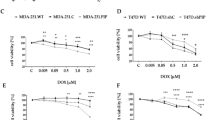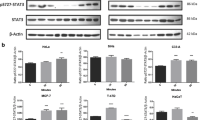Abstract
Prolactin has more than 300 separate functions including affecting mammary growth, differentiation, secretion and anti-apoptosis. In the previous studies, prolactin induced Bcl-2 expression to prevent apoptosis and also provoked the activity of ornithine decarboxylase (ODC). Our previous data showed that ODC overexpression upregulates Bcl-2 and prevents tumor necrosis factor alpha (TNF-α)- and methotrexate (MTX)-induced apoptosis. Here, we further investigate whether prolactin prevents MTX-induced apoptosis through inducing ODC activity and the relationship between ODC and Bcl-2 upon prolactin stimulation. Prolactin prevented MTX-induced apoptosis in a dose-dependent manner in HL-60 cells. Following prolactin stimulation, ODC enzyme activity also shows an increase in a dose-dependent manner, expressing its maximum level at 3 h, and rapidly declining thereafter. Prolactin-induced ODC activity is completely blocked by a protein kinase C delta (PKCδ) inhibitor, rottlerin. However, there are no changes in the expressions of ODC mRNA and protein level after prolactin stimulus. It indicates that prolactin may induce ODC activity through the PCKδ pathway. Besides, Bcl-2 expresses within 1 h of prolactin treatment and this initiating effect of prolactin is not inhibited by alpha-difluoromethylornithine (DFMO). However, Bcl-2 is further enhanced following prolactin stimulation for 4 h and this enhancement is blocked by DFMO. Bcl-2 has no effect on ODC activity and protein levels, but ODC upregulates Bcl-2, which is inhibited by DFMO. Overall, there are two different forms of prolactin effect, it induces Bcl-2 primarily, and following this it stimulates ODC activity. Consequently induced ODC activity further enhances the expression of Bcl-2. The anti-apoptotic effect of prolactin is diminished by DFMO and recovered by putrescine. Obviously, ODC activity is one basis for the anti-apoptotic mechanisms of prolactin. A Bcl-2 inhibitor, HA14-1, together with DFMO, completely blocks the anti-apoptotic effects of prolactin. These results suggest that increasing ODC activity is another way of prolactin preventing MTX-induced apoptosis and that this induction of ODC activity enhances the expression of Bcl-2 strongly enough to bring about the anti-apoptotic function.
Similar content being viewed by others
Abbreviations
- ODC::
-
ornithine decarboxylase
- TNF-α:
-
tumor necrosis factor alpha
- MTX::
-
methotrexate
- PKCδ::
-
protein kinase C delta
- DFMO::
-
alpha-difluoromethylornithine
- ROS::
-
reactive oxygen species
- FBS::
-
fetal bovine serum
- RNase A::
-
ribonuclease A
- PI::
-
propidium iodide
- PBS::
-
phosphate-buffered saline
- RT-PCR::
-
reverse transcriptase polymerase chain reaction
- WT-ODC::
-
overexpressing ODC
- m-ODC::
-
frame-shift mutant ODC
- CKII::
-
casein kinase II
- TPA::
-
12-O-tetradecanoyl-phorbol-13-acetate
- HGF::
-
hepatocyte growth factor.
References
Ben-Jonathan N, Mershon JL, Allen DL, Steinmetz RW. Extrapituitary prolactin: Distribution, regulation, functions, and clinical aspects. Endocr Rev 1996; 17: 639–669.
Walker SE, Jacobson JD. Roles of prolactin and gonadotropin-releasing hormone in rheumatic diseases. Rheum Dis Clin North Am 2000; 26: 713–736.
Perks CM, Keith AJ, Goodhew KL, Savage PB, Winters ZE, Holly JM. Prolactin acts as a potent survival factor for human breast cancer cell lines. Br J Cancer 2004; 91: 305–311.
Ruffion A, Al-Sakkaf KA, Brown BL, Eaton CL, Hamdy FC, Dobson PR. The survival effect of prolactin on PC3 prostate cancer cells. Eur Urol 2003; 43: 301–308.
Perks CM, Newcomb PV, Grohmann M, Wright RJ, Mason HD, Holly JM. Prolactin acts as a potent survival factor against C2-ceramide-induced apoptosis in human granulosa cells. Hum Reprod 2003; 18: 2672–2677.
Krishnan N, Thellin O, Buckley DJ, Horseman ND, Buckley AR. Prolactin suppresses glucocorticoid-induced thymocyte apoptosis in vivo. Endocrinology 2003; 144: 2102–2110.
Fernandez ML, Iglesias MM, Biron VA, Wolfenstein-Todel C. Protective effect of prolactin and placental lactogen on NO-induced Nb2 lymphoma cell apoptosis. Arch Biochem Biophys 2003; 416: 249–256.
Leff MA, Buckley DJ, Krumenacker JS, Reed JC, Miyashita T, Buckley AR. Rapid modulation of the apoptosis regulatory genes, bcl-2 and bax by prolactin in rat Nb2 lymphoma cells. Endocrinology 1996; 137: 5456–5462.
Beck MT, Peirce SK, Chen WY. Regulation of bcl-2 gene expression in human breast cancer cells by prolactin and its antagonist, hPRL-G129R. Oncogene 2002; 21: 5047–5055.
Kochendoerfer SK, Krishnan N, Buckley DJ, Buckley AR. Prolactin regulation of Bcl-2 family members: Increased expression of bcl-xL but not mcl-1 or bad in Nb2-T cells. J Endocrinol 2003; 178: 265–273.
Krumenacker JS, Buckley DJ, Leff MA, et al. Prolactin-regulated apoptosis of Nb2 lymphoma cells: pim-1, bcl-2, and bax expression. Endocrine 1998; 9: 163–170.
Yu-Lee LY. Prolactin stimulates transcription of growth-related genes in Nb2 T lymphoma cells. Mol Cell Endocrinol 1990; 68: 21–28.
Nishiguchi Y, Hibasami H, Komada Y, Sakurai M, Nakashima K. Human promyelocytic cell line HL60 has the specific binding sites for prolactin and its ornithine decarboxylase, DNA synthesis and cellular proliferation are induced by prolactin. Leuk Res 1993; 17: 633–637.
Frungieri MB, Gonzalez-Calvar SI, Calandra RS. Polyamine levels in testes and seminal vesicles from adult golden hamsters during gonadal regression-recrudescence. J Androl 1996; 17: 683–691.
Sauro MD, Bing B, Zorn NE. Prolactin induces growth-related gene expression in rat aortic smooth muscle in vivo. Eur J Pharmacol 1992; 225: 351–354.
Buckley AR, Buckley DJ. Prolactin-stimulated ornithine decarboxylase induction in rat hepatocytes: Coupling to diacylglycerol generation and protein kinase C. Life Sci 1991; 48: 237–243.
LaVoie HA, Witorsch RJ. Investigation of intracellular signals mediating the anti-apoptotic action of prolactin in Nb2 lymphoma cells. Proc Soc Exp Biol Med 1995; 209: 257–269.
Tabor CW, Tabor H. Polyamines. Annu Rev Biochem 1984; 53: 749–790.
Thomas T, Thomas TJ. Polyamines in cell growth and cell death: Molecular mechanisms and therapeutic applications. Cell Mol Life Sci 2001; 58: 244–258.
Moshier JA, Dosescu J, Skunca M, Luk GD. Transformation of NIH/3T3 cells by ornithine decarboxylase overexpression. Cancer Res 1993; 53: 2618–2622.
Auvinen M, Laine A, Paasinen-Sohns A, et al. Human ornithine decarboxylase-overproducing NIH3T3 cells induce rapidly growing, highly vascularized tumors in nude mice. Cancer Res 1997; 57: 3016–3025.
Liu GY, Hung YC, Hsu PC, et al. Ornithine decarboxylase prevents tumor necrosis factor alpha-induced apoptosis by decreasing intracellular reactive oxygen species. Apoptosis 2005; 10: 569–581.
Huang CC, Hsu PC, Hung YC, et al. Ornithine decarboxylase prevents methotrexate-induced apoptosis by reducing intracellular reactive oxygen species production. Apoptosis 2005; 10: 895–907.
Pattillo RA, Gey GO, Delfs E, et al. The hormone-synthesizing trophoblastic cell in vitro: A model for cancer research and placental hormone synthesis. Ann NY Acad Sci 1971; 172: 288–298.
Genestier L, Paillot R, Fournel S, Ferraro C, Miossec P, Revillard JP. Immunosuppressive properties of methotrexate: Apoptosis and clonal deletion of activated peripheral T cells. J Clin Invest 1998; 102: 322–328.
Paillot R, Genestier L, Fournel S, Ferraro C, Miossec P, Revillard JP. Activation-dependent lymphocyte apoptosis induced by methotrexate. Transplant Proc 1998; 30: 2348–2350.
Liu GY, Chen KJ, Lin-Shiau SY, Lin JK. Peroxyacetyl nitrate-induced apoptosis through generation of reactive oxygen species in HL-60 cells. Mol Carcinog 1999; 25: 196–206.
Kao MC, Liu GY, Chuang TC, Lin YS, Wuu JA, Law SL. The N-terminal 178-amino-acid domain only of the SV40 large T antigen acts as a transforming suppressor of the HER-2/neu oncogene. Oncogene 1998; 16: 547–554.
Hour TC, Chen L, Lin JK. Suppression of transcription factor NF-kappaB activity by Bcl-2 protein in NIH3T3 cells: Implication of a novel NF-kappaB p50-Bcl-2 complex for the anti-apoptotic function of Bcl-2. Eur J Cell Biol 2000; 79: 121–129.
Wang Y, Bachrach U. A luminescence-based test for determining ornithine decarboxylase activity. Anal Biochem 2000; 287: 299–302.
Wang JL, Liu D, Zhang ZJ, et al. Structure-based discovery of an organic compound that binds Bcl-2 protein and induces apoptosis of tumor cells. Proc Natl Acad Sci USA 2000; 97: 7124–7129.
Pegg AE, McCann PP. Polyamine metabolism and function. Am J Physiol 1982; 243: 212–221.
Persson L, Wallstrom EL, Nasizadeh S, et al. Regulation of mammalian ornithine decarboxylase. Biochem Soc Trans 1998; 26: 575–579.
Otieno MA, Kensler TW. A role for protein kinase C-delta in the regulation of ornithine decarboxylase expression by oxidative stress. Cancer Res 2000; 60: 4391–4396.
Desiderio MA, Pogliaghi G, Dansi P. Hepatocyte growth factor-induced expression of ornithine decarboxylase, c-met, and c-myc is differently affected by protein kinase inhibitors in human hepatoma cells HepG2. Exp Cell Res 1998; 242: 401–409.
Mitchell JL, Rynning MD, Chen HJ, Hicks MF. Interrelation between the charge isoforms of mammalian ornithine decarboxylase. Arch Biochem Biophys 1988; 260: 585–594.
O'Brien TG, Madara T, Pyle JA, Holmes M. Ornithine decarboxylase from mouse epidermis and epidermal papillomas: Differences in enzymatic properties and structure. Proc Natl Acad Sci USA 1986; 83: 9448–9452.
Persson L, Seely JE, Pegg AE. Investigation of structure and rate of synthesis of ornithine decarboxylase protein in mouse kidney. Biochemistry 1984; 23: 3777–3783.
Worth LL, Cochran BJ, Haddox MK. Phosphorylation of ornithine decarboxylase at both serine and threonine residues in the ODC-overproducing, Abelson virus-transformed RAW264 cell line. Cancer Res 1994; 54: 3967–3970.
Reddy SG, McLlheran SM, Cochran BJ, et al. Multisite phosphorylation of ornithine decarboxylase in transformed macrophages results in increased intracellular enzyme stability and catalytic efficiency. J Biol Chem 1996; 271: 24945–2453.
Tipnis UR, Haddox MK. Characterization of casein kinase II from a virally transformed macrophage-like cell line, RAW264. Cell Mol Biol 1989; 35: 611–626.
Kahana C, Nathans D. Nucleotide sequence of murine ornithine decarboxylase mRNA. Proc Natl Acad Sci USA 1985; 82: 1673–1677.
van Kranen HJ, van de Zande L, van Kreijl CF, Bisschop A, Wieringa B. Cloning and nucleotide sequence of rat ornithine decarboxylase cDNA. Gene 1987; 60: 145–155.
Hickok NJ, Seppanen PJ, Gunsalus GL, Janne OA. Complete amino acid sequence of human ornithine decarboxylase deduced from complementary DNA. DNA 1987; 6:179–187.
Rosenberg-Hasson Y, Strumpf D, Kahana C. Mouse ornithine decarboxylase is phosphorylated by casein kinase-II at a predominant single location (serine 303). Eur J Biochem 1991; 197: 419–424.
Meggio F, Flamigni F, Caldarera CM, Guarnieri C, Pinna LA. Phosphorylation of rat heart ornithine decarboxylase by type-2 casein kinase. Biochem Biophys Res Commun 1984; 122: 997–1004.
Tipnis UR, Haddox MK. Phosphorylation of ornithine decarboxylase by casein kinase II from RAW264 cells. Cell Mol Biol 1990; 36: 275–289.
Mitev V, Bayat-Sarmadi M, Lemnaouar M, Puissant C, Houdebine LM. The effect of prolactin on casein kinase II, MAP kinase and PKC in rabbit mammary cells and Nb2 rat lymphoid cells. Biochem Pharmacol 1996; 52: 1719–1727.
Legraverend C, Potter A, Holtta E, Andersson LC. Interleukin-2 regulates the activity of ornithine decarboxylase in a cloned murine T lymphocytic cell line: Evidence for a protein kinase C-dependent pathway. Exp Cell Res 1989; 181: 282–288.
Waters SB, Rillema JA. Role of protein kinase C in the prolactin-induced responses in mouse mammary gland explants. Mol Cell Endocrinol 1989; 63: 159–166.
Butler AP, Cohn WB, Mar PK, Montgomery RL. Regulation of ornithine decarboxylase mRNA by phorbol esters and insulin in normal and C-kinase-deficient rat hepatoma cells. J Cell Physiol 1991; 147: 256–264.
Wheeler DL, Reddig PJ, Dreckschmidt NE, Leitges M, Verma AK. Protein kinase Cdelta-mediated signal to ornithine decarboxylase induction is independent of skin tumor suppression. Oncogene 2002; 21: 3620–3630.
Jansen AP, Dreckschmidt NE, Verwiebe EG, Wheeler DL, Oberley TD, Verma AK. Relation of the induction of epidermal ornithine decarboxylase and hyperplasia to the different skin tumor-promotion susceptibilities of protein kinase C alpha, -delta and -epsilon transgenic mice. Int J Cancer 2001; 93: 635–643.
Coffino P. Regulation of cellular polyamines by antizyme. Nat Rev Mol Cell Biol 2001; 2: 188–194.
Ploszaj T, Motyl T, Zimowska W, Skierski J, Zwierzchowski L. Inhibition of ornithine decarboxylase by alpha-difluoromethylornithine induces apoptosis of HC11 mouse mammary epithelial cells. Amino Acids 2000; 19: 483–496.
Ploszaj T, Motyl T, Orzechowski A, et al. Antiapoptotic action of prolactin is associated with up-regulation of Bcl-2 and down-regulation of Bax in HC11 mouse mammary epithelial cells. Apoptosis 1998; 3: 295–304.
Weimann E, Baixeras E, Zamzami N, Kelly P. Prolactin blocks glucocorticoid induced cell death by inhibiting the disruption of the mitochondrial membrane. Leuk Res 1999; 23: 751–762.
Author information
Authors and Affiliations
Corresponding author
Rights and permissions
About this article
Cite this article
Hsu, PC., Hour, TC., Liao, YF. et al. Increasing ornithine decarboxylase activity is another way of prolactin preventing methotrexate-induced apoptosis: Crosstalk between ODC and BCL-2. Apoptosis 11, 389–399 (2006). https://doi.org/10.1007/s10495-006-4002-0
Published:
Issue Date:
DOI: https://doi.org/10.1007/s10495-006-4002-0




